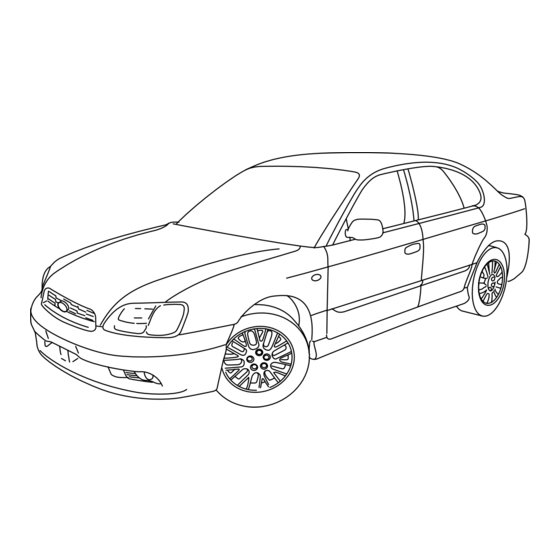
Table of Contents
Advertisement
Quick Links
Foreword
Congratulations on choosing a SUBARU vehicle. This Owner's Man-
ual has all the information necessary to keep your SUBARU in excel-
lent condition and to properly maintain the emission control system
for minimizing emission pollutants. We urge you to read this manual
carefully so that you may understand your vehicle and its operation.
For information not found in this Owner's Manual, such as details
concerning repairs or adjustments, please contact the dealer from
whom you purchased your SUBARU or the nearest SUBARU dealer.
The information, specifications and illustrations found in this manual
are those in effect at the time of printing. FUJI HEAVY INDUSTRIES
LTD. reserves the right to change specifications and designs at any
time without prior notice and without incurring any obligation to
make the same or similar changes on vehicles previously sold. This
Owner's Manual applies to all models and covers all equipment, in-
cluding factory installed options. Some explanations, therefore may
be for equipment not installed in your vehicle.
Please leave this manual in the vehicle at the time of resale. The next
owner will need the information found herein.
FUJI HEAVY INDUSTRIES LTD., TOKYO, JAPAN
and
are registered trademarks of FUJI HEAVY INDUSTRIES, LTD.
© copyright 2003 FUJI HEAVY INDUSTRIES LTD.
Advertisement
Chapters
Table of Contents

Summarization of Contents
Warranties
Warranties for U.S.A.
Details warranty coverage for vehicles distributed in the USA.
Warranties for Canada
Details warranty coverage for vehicles distributed in Canada.
How to use this owner’s manual
Using your Owner’s manual
Explains the structure and purpose of the owner's manual.
Chapter 1: Seat, seatbelt and SRS airbags
Covers seat, seatbelt, and SRS airbag usage and precautions.
Chapter 7: Starting and operating
Instructions on starting and operating the vehicle.
Chapter 9: In case of emergency
Procedures for handling emergencies like flat tires or breakdowns.
Safety precautions when driving
Seatbelt and SRS airbag
Guidelines for using seatbelts and SRS airbags.
Child safety
Precautions and instructions for child safety in the vehicle.
Engine exhaust gas (carbon monoxide)
Warnings and precautions regarding engine exhaust gas exposure.
Seat, seatbelt and SRS airbags
Front seats
Adjustments and precautions for front seats.
Seatbelts
Detailed information and safety tips for seatbelt usage.
Child restraint systems
Guidance on selecting, installing, and using child restraint systems.
Keys and doors
Keys
Information on the different types of keys and their usage.
Door locks
Instructions on locking and unlocking doors.
Remote keyless entry system (if equipped)
Functions and operation of the remote keyless entry system.
Instruments and controls
Ignition switch
Positions and operation of the ignition switch.
Warning and indicator lights
Meanings and operations of various warning and indicator lights.
Wiper and washer
Operation of windshield and rear window wipers and washers.
Starting and operating
Fuel
Information on fuel requirements, octane rating, and types.
Starting the engine
Procedures for starting the engine.
Driving tips
General advice and precautions for safe driving.
Driving tips
Winter driving
Tips and precautions for driving in winter conditions.
Driving tips for AWD vehicles
Specific driving advice for All-Wheel Drive vehicles.
Loading your vehicle
Guidelines and warnings for safely loading the vehicle.
In case of emergency
Flat tires
Step-by-step guide for changing a flat tire.
Jump starting
Procedure and safety warnings for jump starting the vehicle.
Engine overheating
What to do if the engine overheats.
Appearance care
Exterior care
Guidelines for washing, waxing, and polishing the exterior.
Corrosion protection
Common causes of corrosion and methods to prevent it.
Cleaning the interior
Procedures for cleaning interior surfaces like fabric and leather.
Maintenance and service
Maintenance schedule
Schedule of required maintenance services at regular intervals.
Maintenance precautions
General precautions to follow when performing maintenance.
Engine oil
Procedures for checking and changing engine oil.
Specifications
Dimensions
Vehicle dimensions for Sedan and Wagon, Legacy and Outback models.
Engine
Engine models, types, displacement, bore, stroke, compression, and firing order.
Fuses and circuits
Location, rating, and circuit for fuses in the vehicle.
Consumer information and Reporting safety defects
Tire information
Explanation of tire labeling, size, and load/speed ratings.
Adverse safety consequences of under-inflation
Risks associated with under-inflated tires.
Steps for Determining Correct Load Limit
Method for calculating the vehicle's load capacity.
















Need help?
Do you have a question about the 2004 outback and is the answer not in the manual?
Questions and answers